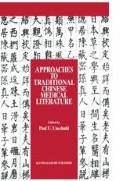Abstract
Several Chinese medical classics, including the Huang-ti Nei-ching Su-wen 黃帝內經素問, Huang-ti Nei-ching Ling-shu 黃帝內經靈樞and the Shang-han Lun 傷寒論are still used in Japan as textbooks of traditional medicine. However, certain concepts and passages in these texts are extremely difficult and have been subject to different interpretations and distortions. This is partly due to lack of information regarding the social background that affected the formation of these concepts. This, in turn, is because the date of compilation of the original texts is not precisely known. Moreover, many of the incomprehensible words and passages are presumed to have resulted from errors made when the texts were copied by hand in ancient times. Again, these remain unexplained because their original form is unknown.
Access this chapter
Tax calculation will be finalised at checkout
Purchases are for personal use only
Preview
Unable to display preview. Download preview PDF.
Notes
Keiji Yamada, ed. 山田慶兒, Shinhatsugen chugoku kagakushi shiryo no kenkyu, Yakuchu hen 新發現中國科學史資料o 研究譯注篇 (Recently Found Materials for the Study of the History of Chinese Natural Science, Translation Part), 1985, the Research Institute for Humanistic Studies, Kyoto University
ibid., Ronko hen 論考篇 (Essay Part).
Hiroshi Kosoto 小曾戶洋, “An Introductory Study on the Hsiao-p’in Fang with Reference to a Recently Discovered Old Manuscript” 小品方序說一現备 L/二古卷子本, Journal of the Japanese Society for Medical History日本醫史學雜誌 32 (1986): 1.
The Hunan Provincial Museum and the Institute of Archaeology, Academy of Science 湖南省博物, 中國科學院考古研究所, “Excavation of the Han Tombs 2 and 3 at Ma-wang-tui, Changsha” 長沙馬王堆二三號漢墓發掘簡報, Wen-wu文物7 (1974): 39.
Ma Chi-hsing 馬繼興“Ancient Medical Literature Unearthed from Ma-wang-tui” 馬王堆出土的古醫書 Chinese Journal of Medical History 中華醫史雜誌 10.4 (1981): 41.
Department of Medical History, Academy of Chinese Medicine 中醫研究院醫史文獻研究室“A Brief Report of Four Medical Silk Manuscripts Found in the Han Tomb at Ma-wang-tui, Changsha” 馬王堆帛書四種古醫學佚書簡介, Wen-wu 6 (1975): 16.
The Kansu Provincial Museum and Wu-wei Cultural Center 甘肅省博物館武威縣文化館Wu wei Han-tai I- chien 武威漢代醫簡 (Wu-wei Medical Manuscript Written During the Han Dynasty), Peking: Wen-wu Publishing 文物出版社, 1975.
The Chang-chia-shan Bamboo Strips Study Group 張家山漢墓竹簡整理小組, “Notes on the Han Dynasty Bamboo Strips Unearthed at Chang-chia-shan in Chiangling” 江陵張家山漢簡槪述Wen-wu 1 (1985): 9.
Luo Chen-yü 羅振玉 and Wang Kuo-wei 王國維, Liu-Sha Chui-chien 流沙墜簡, 1914’ and Shang-yü Luo-shih Ch’en-han Lou 上虞羅氏宸翰樓; also, Lao Kan 勞幹, Documents of the Han Dynasty on Wooden Slips from Edsin Gol, Part 2: Transliterations and Commentaries 居延漢簡, 考釋之部, The Institute of History and Philology, Academica Sinica 中央研究院歷史語言硏究所, Taipei.
Study Group for Han Silk Manuscripts from Ma-wang-tui 馬王堆漢墓帛書整理小組, Wu-shih-erh Ping-fang 五十二病方Prescriptions for Fifty-two Illnesses), Peking: Wen-wu Publishing, 1979.
Ma-Wang-tui han-mu po-shu cheng-li hsiao-tsu, ed. 馬下堆漢墓帛書整理小組 Ma-wang-tui Han-mu Po-shu 4 馬王堆漢墓帛書 (Han Silk Manuscripts from Ma-wang-tui), Peking: Wen-wu Publishing, 1985.
The Kansu Provincial Museum 甘肅省博物館, “Excavation of the Eastern Han Tomb at Han-t’an-p’o in Wu-wei County, Kansu Province, and the Discovery of Numerous Wooden Slips Inscribed with Medical Prescriptions,” Wen-wu 12 (1973): 18.
Akahori Akira 赤堀昭, “Medical Use of Drugs Recorded in the Shen-nung Pen-ts’ao Ching” 神農本草經〔記載 找亡藥考, J. Jap. Soc. Med. Hist, 24 (1978): 1.
Akahori Akira, “Yeh Method”冶法旮趵 < 石問題, in Yamada, 1985 (vide ante, note 1), 123.
Yang Shang-shan notes the following in the Tai-su: “The fox cannot discharge urine during the night. It first discharges at dawn. Because the disease is similar to that of the fox, it is named hu-ching” In the Chien-ming Chung-i Tz’u-tien 簡明中醫辭典Jen-min Wei-sheng Ch’u-pan She 人民衞生出版社1979), it is described as follows: “When the disease breaks out, part of the abdominal tissue and ileum pass down into the scrotum. The scrotum then enlarges and contracts in turn. Pain follows the enlargement of the scrotum. Because the progress of the disease is similar to the appearance and disappearance of the fox, it is named hu-shan.”
Akahori Akira, “A Study of the Yin-yang Shih-i Mai Chiu Ching” 陰陽十一脈灸經◦研究, Toho gakuho 53 (1981): 299.
Keiji Yamada, “The Formation of the Huang-ti Nei-ching,” Acta Asiatica 36 (1979): 67
idem, “The Theory of the Nine Palaces and the Eight Winds and the Standpoint of the Shao-shih Group” 九宮八風說 少師派o立場, Toho gakuho 52 (1980): 199.
Akahori Akira, “The Han Medical Documents on Wood Discovered at Wu-wei”武威漢代醫簡伫々l、tﻰ, Toho gakuho 50 (1978): 75.
“A Comparative Study of the Shang-han Lun with Recently Excavated Manuscripts” 新出土資料 i 傷寒論, Chui Rinsho 中醫臨床 3 (1982): 91.
Editor information
Editors and Affiliations
Rights and permissions
Copyright information
© 1989 Kluwer Academic Publishers
About this chapter
Cite this chapter
Akira, A. (1989). The Interpretation of Classical Chinese Medical Texts in Contemporary Japan: Achievements, Approaches, and Problems. In: Unschuld, P.U. (eds) Approaches to Traditional Chinese Medical Literature. Springer, Dordrecht. https://doi.org/10.1007/978-94-009-2701-8_3
Download citation
DOI: https://doi.org/10.1007/978-94-009-2701-8_3
Publisher Name: Springer, Dordrecht
Print ISBN: 978-94-010-7717-0
Online ISBN: 978-94-009-2701-8
eBook Packages: Springer Book Archive

